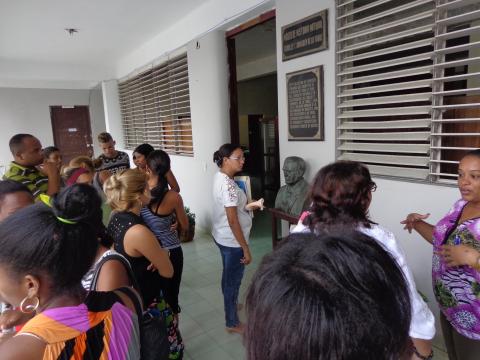
The celebration of its 65th anniversary this week brought together members of the P4 of the VLIR-IUC. This project (P4) is channeled into the promotion of the study and recognition of Santiago de Cuba heritage from the Social and Humanistic Sciences.
Ph.D. Margarita Hernández Garrido remarked the different stages of scientific research that have taken place in the Museum since its foundation in 1952 until current times. "Up to 1990, some research were conducted on the biological aspects of the collections held here, as well as their impact on the development of the natural sciences in the country’’, Garrido said. ´´Then, and until about 2011, we conducted some exhaustive research on the life and work of Charles Ramsden and on various topics of environmental education. Currently, museographic studies have been undertaken; for example, a better arrangement of the bird collection has been proposed, and Charles Ramsden is recognized as one of the most important figures of Santiago's science and culture of the last century. "
During his prolific academic life, Charles Ramsden (1876-1951) discovered more than 30 species, including the Gallinuela de Agua Dulce, currently on display in this site. Since his death, on August 28th, 1951; the University administration was interested in acquiring its vast collection, acquisition that was completed on April 30th, 1952 under agreements intended to preserve it with teaching, research and nonprofit dissemination purposes. According to the historian Ariadna Rosales, there are 180 species of birds on display in the exhibition rooms of this institution, 22 of them are endemic, and the second most important collection of butterflies in the country is still held and preserved here.
The celebration of the 65th anniversary of the Charles Ramsden Natural History Museum, the first official activity of the recently created Heritage Department of the Universidad de Oriente, was attended by researchers and students from the majors of Child Education, History of Art, History and others related to the program of research that, among its objectives, fosters the strengthening of university museums as an important part in the rescue of the historical, archaeological, legal, artistic and cultural heritage of this city.
PhD Frank Josué Soler, Head of this Department, explained that one of the main problems being tackled today is the ignorance of the existence of places like this "It is necessary to gather the forces of all stakeholders, find all the loopholes to get the necessary resources to conserve and administer this museum. It is necessary to think about its functionality. The department I manage intends to promote the work of these spaces and foster environmental education from our university classrooms. Also, we count on everyone for this, that is what really matters".
Likewise, PhD Bernardo Reyes Tour decided to study some aspects still unknown of Ramsden's legacy, for example, the correspondence he had with his cousin Carlos de la Torre, another eminent Cuban intellectual who served as Rector of the University of Havana.
With plenty of work to do in regards to the dissemination of its collections and the management and conservation of this natural heritage, the Museum of Natural History of the Universidad de Oriente will continue to be in the many years to come, that small and extraordinary place to which many more visitors must arrive.
PhD Bernardo Reyes Tour, Biologist specialized, spoke out about studying unknown aspects of Ramsden's legacy.
During a tour around the Museum, the students learned about the scientific work of this eminent intellectual from Santiago.
La Gallinuela de Agua Dulce, one of the 200 species discovered by Charles Ramsden.
The Charles Ramsden Natural History Museum holds the second largest collection of Cuban butterflies in the country. Photos: Daylenis Blanco

